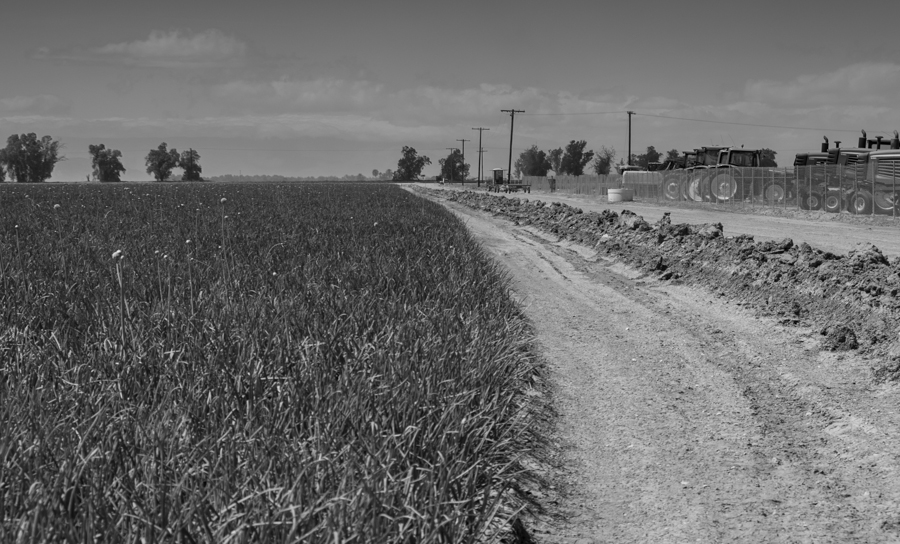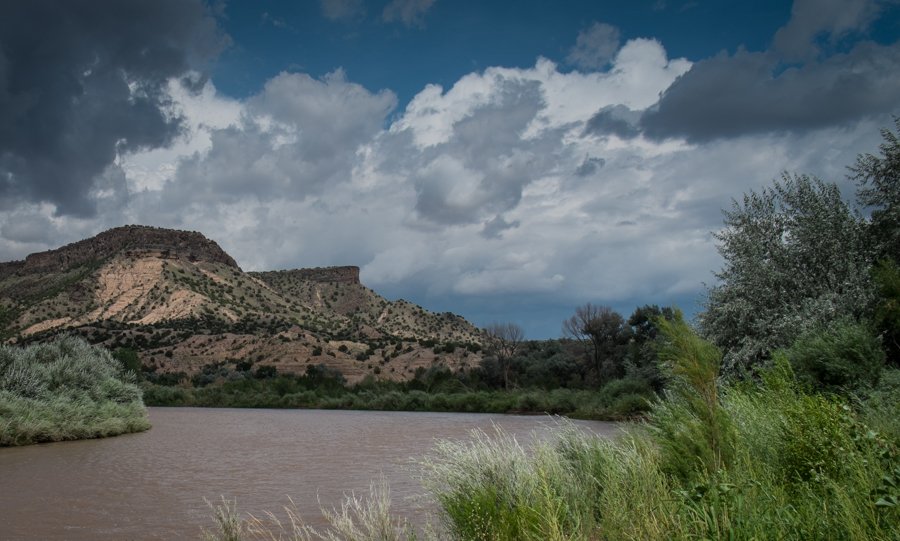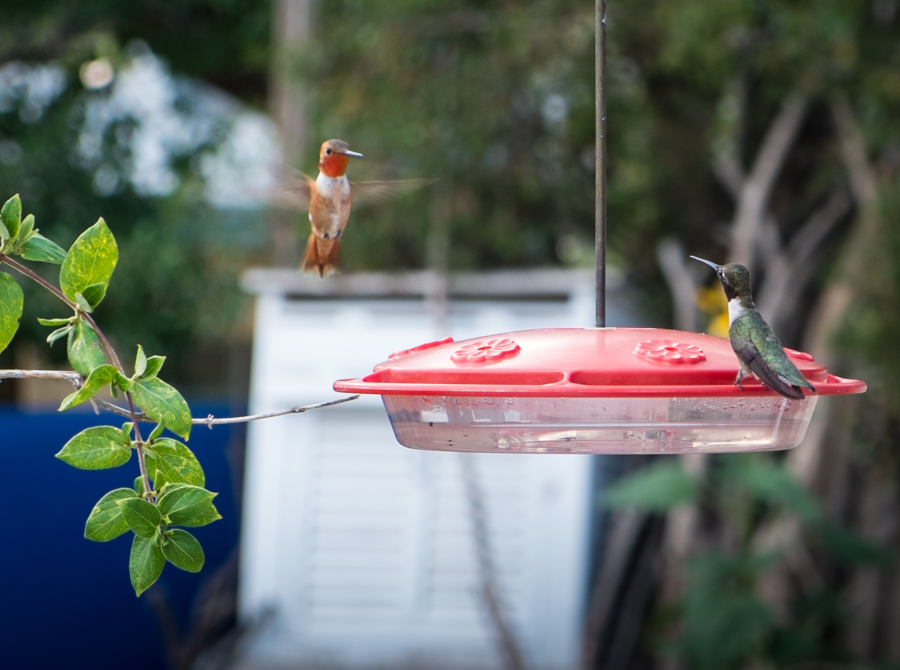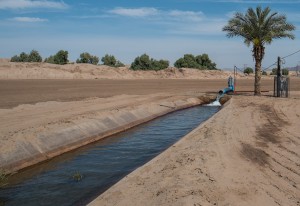One more hummingbird picture
Sorry, can’t resist posting one more hummingbird picture. The rufous, on the left, have just finally arrived at our house. They’re usually earlier in the summer, and they’re very aggressive, driving away the black-chins who have been here since late spring. Moments after this picture was snapped, the rufous drove the black-chin away:
Hummingbird
Annals of ag-urban transfers: Imperial Valley, December 2002
The Imperial Irrigation District has more Colorado River water than anyone else. That has put them at the center of every major Colorado River Basin conversation about the transfer of agricultural water to urban users, including a particularly dramatic bit of brinksmanship going on in the fall of 2002.
The other states of the basin were pushing hard to for California to live within its 4.4 million acre foot per year allocation, which it had been breaching for years by using surplus water unused by the other states of the basin. By the 1990s, with the Central Arizona Project coming on line and Nevada finally growing its its full allocation, the gravy train was ending. California pleaded for time, and the other states agreed to provide a “soft landing” – bonus water for a few more years in turn for ironclad guarantees – an enforceable plan – to get down to 4.4maf.
That mean a big ag->urban transfer of water, which meant the Imperial Irrigation District board had to sign off on the deal. With the clock ticking toward an end-of-2002 deadline, the IID board gathered at 6 p.m. Dec. 9, 2002, at the agency’s El Centro headquarters.
Antonio Ramos, from Calexico, held up a plastic milk jug with just a bit of water in the bottom and pleaded to the board members:
If it goes through we will have no water and the Valley will become another Owens Valley – dead…. Nobody has the right to sell the water. Don’t be a Scrooge and ruin Christmas for everybody.
There is much more in the minutes, which I ran across while doing book research (thanks IID!), including activists from the metro area urging the board to keep the water on the farms and an apparently anguished Mike Cox of the Farm Bureau. The minutes, posted below, are a wonderful example of what I love to call “the pageant of democracy”.
The board voted down the agreement 3-2. Three weeks later, California’s deliveries were cut to 4.4 maf, and the world didn’t end.
Is the basin the wrong scale to look at Colorado River (or Rio Grande) system groundwater losses?
I think the answer to my rhetorical question in this post’s headline is obviously “no”. I think this is enormously useful data. But I’m still puzzling over who beyond clickbaiting bloggers like myself might use it, and how.
In his coverage of the GRACE Colorado Basin groundwater depeletion, Brett Walton at Circle of Blue included an interesting comment from Arizona’s Chuck Collum:
Chuck Cullom, Colorado River manager at the Central Arizona Project, which delivers more than half of Arizona’s Colorado River allocation, said the study was helpful.
“The study is useful in using GRACE to verify at a coarse scale what water managers in the Basin know,” Cullom told Circle of Blue.
I’ve been thinking about that because the new GRACE study triggered (yet again) a discussion among some of the local water nerds about the need for such a study on the Rio Grande, something I’ve told Jay Famiglietti and Stephanie Castle that I’d be really appreciative if they’d do. In the past, I’ve used some of their data in my newspaper work, but only in a very general way:
Groundwater across the entire state, especially on New Mexico’s east side, is dwindling, according to research by the University of California’s Jay Famiglietti, who uses satellites to measure changes in the aquifer, the fresh water underground that is pumped up for use on farms and in cities.
“The trend is pretty significant,” Famiglietti said.
I’d really love to have more detail, a Rio Grande Basin study like the one just completed on the Colorado, but Cullom’s comment got me thinking about who might actually use data at the basin scale. If management of groundwater is done at a state and local scale, and if Cullom is right that water managers at that scale already know what’s going on with their own groundwater, then what is a basin-wide number telling us that might be used in policy implementation that is different than the data local-level water managers already have?
Ag-urban transfers: “a significant fission of costs and benefits”

In ag-urban water transfers, does the tractor dealer lose out? Onion field and tractor dealership, Imperial Valley, March 2014, by John Fleck
More from in Brian Devine’s excellent series on the tradeoffs, some quite hidden, in the agricultural-to-urban water transfers that seem the inevitable path forward in the western United States:
To many rural communities, water is more than just money. Irrigation is the lifeblood of rural communities’ economies, to be sure, but it is also a key strand in the fabric of community identities and the self-determination of rural places.
And this (“AMI” is “agricultural to municipal-industrial”):
Third parties – the employees and neighbors of those who choose to sell water, and who receive no cut of the sale price – therefore bear most of the economic burdens of AMI transfers. Removing the primary economic driver from these communities has little to no effect on productivity from a state or national accounting standpoint, but it can have a cascading effect on local capacity. Unsurprisingly, the effects are smaller when the receiving area and the origin are in the same economic region. This case is not uncommon as suburbs expand into and even “leapfrog” over agricultural operations. But the opposite case, where water is transferred many miles away along a stream, or even through a tunnel into entirely different watersheds, represents a significant fission of costs and benefits.
I tend to be optimistic about the role of ag-urban transfers, but these third-party effects can’t be easily waved away.
Stuff I helped write elsewhere: Endangered Species Act litigation on the Rio Grande
From this morning’s Albuquerque Journal (behind a GoogleSurveyWall for non-subscribers, sorry):
Citing “two decades of broken promises by federal and state water managers,” a Santa Fe-based environmental group filed a federal lawsuit against two government agencies Thursday alleging they failed “to secure dynamic and perennial flows for the Rio Grande” needed to protect the silvery minnow and Southwestern willow flycatcher.
Water managers of one agency say they have made major changes in how they operate, while another said it has spent at least $50 million over the past decade to protect the fish.
Policy implications of Castle and colleagues on Colorado River Basin groundwater depletions
Ever since we saw early glimpses last spring of data from Stephanie Castle, Jay Famiglietti and colleagues about groundwater depletion in the Colorado River Basin, I’ve been puzzling over the policy implications. Their data, published today in GRL, is worth an “OMG IT’S WORSE THAN WE THOUGHT!” While we’ve been watching Lake Mead’s bathtub ring grow and the basin has lost 12 million acre feet of stored surface water in the last decade, aquifers have declined more than 40 million feet, essentially unnoticed.
In a fascinating talk in the spring at the Bureau of Reclamation, Oregon State University’s Aaron Wolf, the guru of water conflict (or lack thereof) explained how his data showed collaboration and cooperation is far more common than fighting over water. The key thing to look for is how a basin’s water users are able to respond to change. Change can be abrupt, like flooding, or drawn out, like drought or the sort of inexorably rising demand that we’re seeing in the Colorado Basin. Actually, we’ve got drought too, so check that off. At this point you look to institutions:
There’s change in the basin. All the things you look for. Scarcity, floods, droughts, economic growth, tensions. Everything that’s going on. Managing that is a certain level of institutional capacity. How good are the agreements? How good are the relationships? How well do they work together? That helps mitigate the change…. The likelihood of conflict rises as the rate of change in a basin exceeds the institutional capacity to absorb the change.
I’ve been arguing that one of the things we see in the Colorado River Basin is an institutional maturity that has thus far had the ability to absorb the changes we’ve seen to date – the 2001 Interim Surplus Guidelines that jiggered Colorado Basin allocations to rein in California’s overuse (pdf), the 2007 shortage sharing agreement, the remarkable Minute 319 deal with Mexico. Those institutions are now wrestling with the fact that none of this has been enough, which is why maybe this week we’ll see the announcement of a system conservation program deal that will be one more brick in that wall.
All of that shows the maturity, I think of basin-wide water management institutions. Only time will tell of that’s enough, but it’s the sort of thing Wolf’s research shows is a necessary precondition to success. But all of those institutions deal with surface water. What Castle and colleagues are pointing out is that groundwater drawdown is a huge unaddressed problem. And we’ve got no basin-wide institutions for that.
Maybe we simply don’t need them. One of the core principles of basin management is that we need these institutional arrangements because the Colorado River and its tributaries flow alongside or through nine different states. One of the key institutional approaches has been to set allocations at the states’ borders and leave each state to deal with its own internal allocations within its own state-by-state institutions. That’s where groundwater institutions lie. Each state has its own (and they’re widely varied – in preparing for this post I found a few reviews explaining how each state handles its own groundwater, and for now I’ll just categorize them as “tl;dr” – too long, didn’t read :-).
The short answer, then, is that if an individual state has permitted overpumping, that state is going to have to deal with the consequences. This isn’t a basin-wide problem, so much as seven individual problems, for seven individual states.
But even if that assessment is correct, it still becomes a basin-wide problem if groundwater problems at home make it more difficult for the states to make the water-sharing and curtailment decisions that are going to be needed to cobble together overarching solutions to the Colorado River Basin’s problems as a whole. Does groundwater depletion add a level of difficulty that exceeds our institutional capacity to absorb change?
What Castle and her colleagues have given us is enormously helpful, but it’s only the start. It’s gross data. To understand the implications, we really need to drill down now to a much more local level – who’s doing all this pumping, where, and what are the implications at a zillion local watershed scales?
That’s how we’ll figure out where we are on Wolf’s scale of institutional readiness to deal with a problem that’s bigger than I thought it was before I saw this data.
New data shows Colorado Basin groundwater loss greater than reservoir shrinkage
While we’ve been watching Lake Mead and Lake Powell drop during the last decade, the hidden reservoirs of groundwater beneath the Colorado River Basin have been dropping even faster, according to new research by Stephanie Castle and her colleagues at U.C. Irvine. Using gravity data from NASA’s GRACE satellite (the new tool all the cool kids are using to study groundwater), Castle and colleagues have posted up some striking data.
In the time period, they studied, 2004-13, they identified a total of 12 million acre feet of water lost as we drew down reservoirs. That’s the white bathtub ring in Lake Mead, the drop in Lake Powell, and the reductions in storage in smaller reservoirs – the stuff we can see. But they also found a whopping 40.5 million acre feet of loss in aquifer storage, as folks pumped groundwater to make up for surface water shortfalls.
This has significant policy implications, because essentially all the basin-scale policy discussions focus on surface water, while dealing with residual problems left by groundwater shortfalls left to state governance:
While the need to exploit groundwater resources to meet Basin water demands has long been recognized, withdrawals required to meet current demands remain undocumented and are uncertain in the future. In particular, water management under drought conditions focuses on surface water resources without a regulatory framework to manage groundwater withdrawals outside of “river aquifer” systems. At question is the potential impact of solely managing surface water allocations and diversions in the Basin, without regard to groundwater loss, on meeting future water demands.
(I don’t have a link yet, will add one as soon as it’s available.)
Here’s a link to the paper, and Jay Famiglietti, one of the authors, has a writeup over at National Geographic. Also, AGU news release.
Pressure increasing to do something about a dropping Lake Mead
With a meeting coming up Friday of representatives of the seven Colorado River basin states, pressure is increasing to do something about the dropping reservoir levels in the basin, Tony Davis reports:
“How urgent it is depends on what you think the risk is,” said attorney Wade Noble, who has represented Yuma-area irrigation districts for 30 years. “If the risk is high that the water is not going to be there … then something needs to be done in the immediate future, not next year.”
The entire story is worth clicking for.




